Impact of Covid-19 on Employee Satisfaction: UK Report
VerifiedAdded on 2022/01/18
|7
|2138
|42
Report
AI Summary
This report investigates the impact of COVID-19 on employee satisfaction, focusing on the UK business landscape and specifically examining the Crown Oil Company. The research explores the challenges of remote work, work-life balance, and the strategies companies can use to maintain employee morale and productivity. The report includes a literature review of relevant studies, a detailed research methodology employing the Saunders onion model, and a survey approach for data collection. The study addresses key research questions about work-life balance, the effects of work pressure, and the overall impact of the pandemic on job satisfaction. The findings are intended to provide insights into the factors affecting employee well-being and offer recommendations for businesses navigating the changing work environment. The report also includes a cost analysis and addresses ethical considerations related to data collection and privacy.
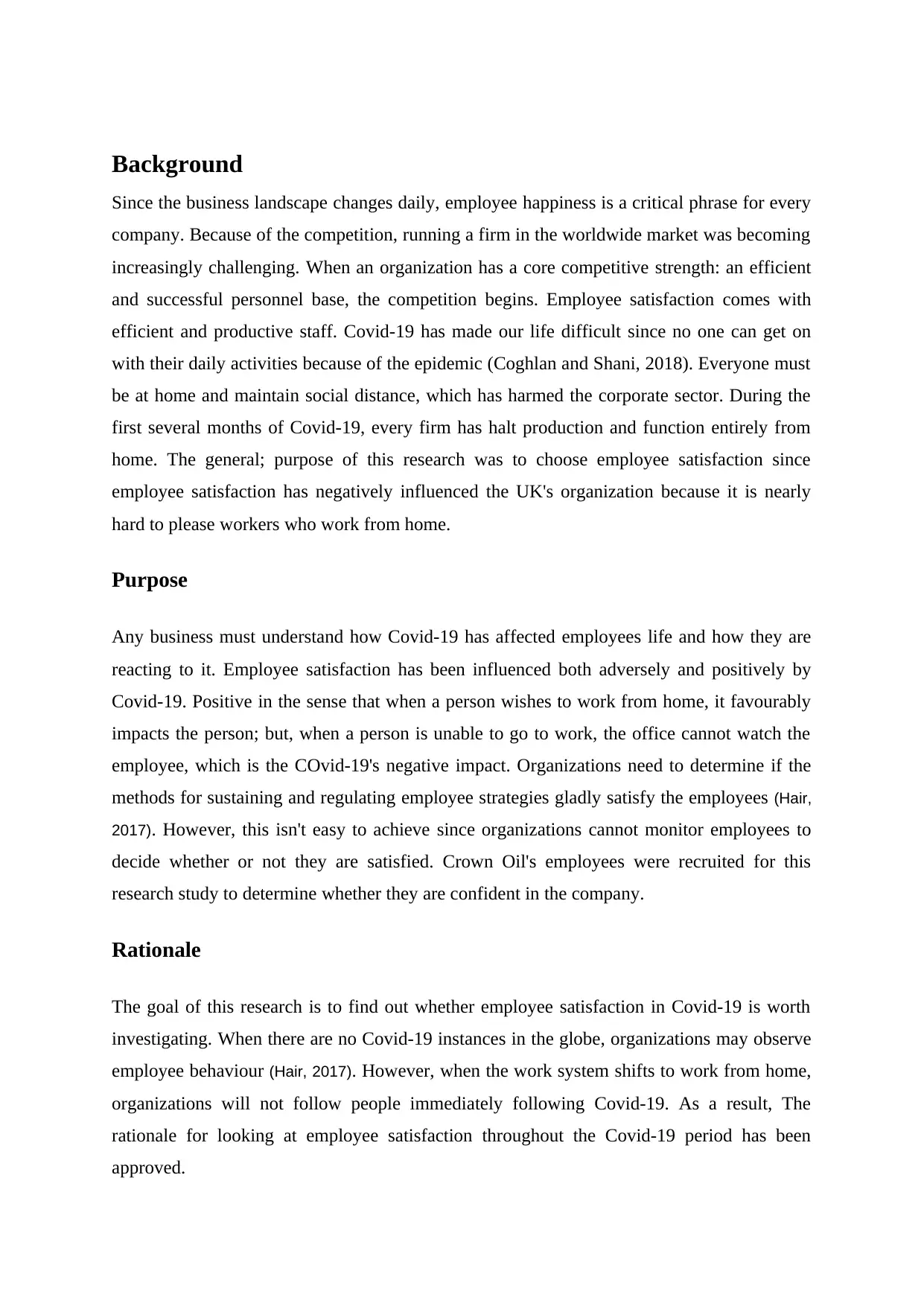
Background
Since the business landscape changes daily, employee happiness is a critical phrase for every
company. Because of the competition, running a firm in the worldwide market was becoming
increasingly challenging. When an organization has a core competitive strength: an efficient
and successful personnel base, the competition begins. Employee satisfaction comes with
efficient and productive staff. Covid-19 has made our life difficult since no one can get on
with their daily activities because of the epidemic (Coghlan and Shani, 2018). Everyone must
be at home and maintain social distance, which has harmed the corporate sector. During the
first several months of Covid-19, every firm has halt production and function entirely from
home. The general; purpose of this research was to choose employee satisfaction since
employee satisfaction has negatively influenced the UK's organization because it is nearly
hard to please workers who work from home.
Purpose
Any business must understand how Covid-19 has affected employees life and how they are
reacting to it. Employee satisfaction has been influenced both adversely and positively by
Covid-19. Positive in the sense that when a person wishes to work from home, it favourably
impacts the person; but, when a person is unable to go to work, the office cannot watch the
employee, which is the COvid-19's negative impact. Organizations need to determine if the
methods for sustaining and regulating employee strategies gladly satisfy the employees (Hair,
2017). However, this isn't easy to achieve since organizations cannot monitor employees to
decide whether or not they are satisfied. Crown Oil's employees were recruited for this
research study to determine whether they are confident in the company.
Rationale
The goal of this research is to find out whether employee satisfaction in Covid-19 is worth
investigating. When there are no Covid-19 instances in the globe, organizations may observe
employee behaviour (Hair, 2017). However, when the work system shifts to work from home,
organizations will not follow people immediately following Covid-19. As a result, The
rationale for looking at employee satisfaction throughout the Covid-19 period has been
approved.
Since the business landscape changes daily, employee happiness is a critical phrase for every
company. Because of the competition, running a firm in the worldwide market was becoming
increasingly challenging. When an organization has a core competitive strength: an efficient
and successful personnel base, the competition begins. Employee satisfaction comes with
efficient and productive staff. Covid-19 has made our life difficult since no one can get on
with their daily activities because of the epidemic (Coghlan and Shani, 2018). Everyone must
be at home and maintain social distance, which has harmed the corporate sector. During the
first several months of Covid-19, every firm has halt production and function entirely from
home. The general; purpose of this research was to choose employee satisfaction since
employee satisfaction has negatively influenced the UK's organization because it is nearly
hard to please workers who work from home.
Purpose
Any business must understand how Covid-19 has affected employees life and how they are
reacting to it. Employee satisfaction has been influenced both adversely and positively by
Covid-19. Positive in the sense that when a person wishes to work from home, it favourably
impacts the person; but, when a person is unable to go to work, the office cannot watch the
employee, which is the COvid-19's negative impact. Organizations need to determine if the
methods for sustaining and regulating employee strategies gladly satisfy the employees (Hair,
2017). However, this isn't easy to achieve since organizations cannot monitor employees to
decide whether or not they are satisfied. Crown Oil's employees were recruited for this
research study to determine whether they are confident in the company.
Rationale
The goal of this research is to find out whether employee satisfaction in Covid-19 is worth
investigating. When there are no Covid-19 instances in the globe, organizations may observe
employee behaviour (Hair, 2017). However, when the work system shifts to work from home,
organizations will not follow people immediately following Covid-19. As a result, The
rationale for looking at employee satisfaction throughout the Covid-19 period has been
approved.
Paraphrase This Document
Need a fresh take? Get an instant paraphrase of this document with our AI Paraphraser
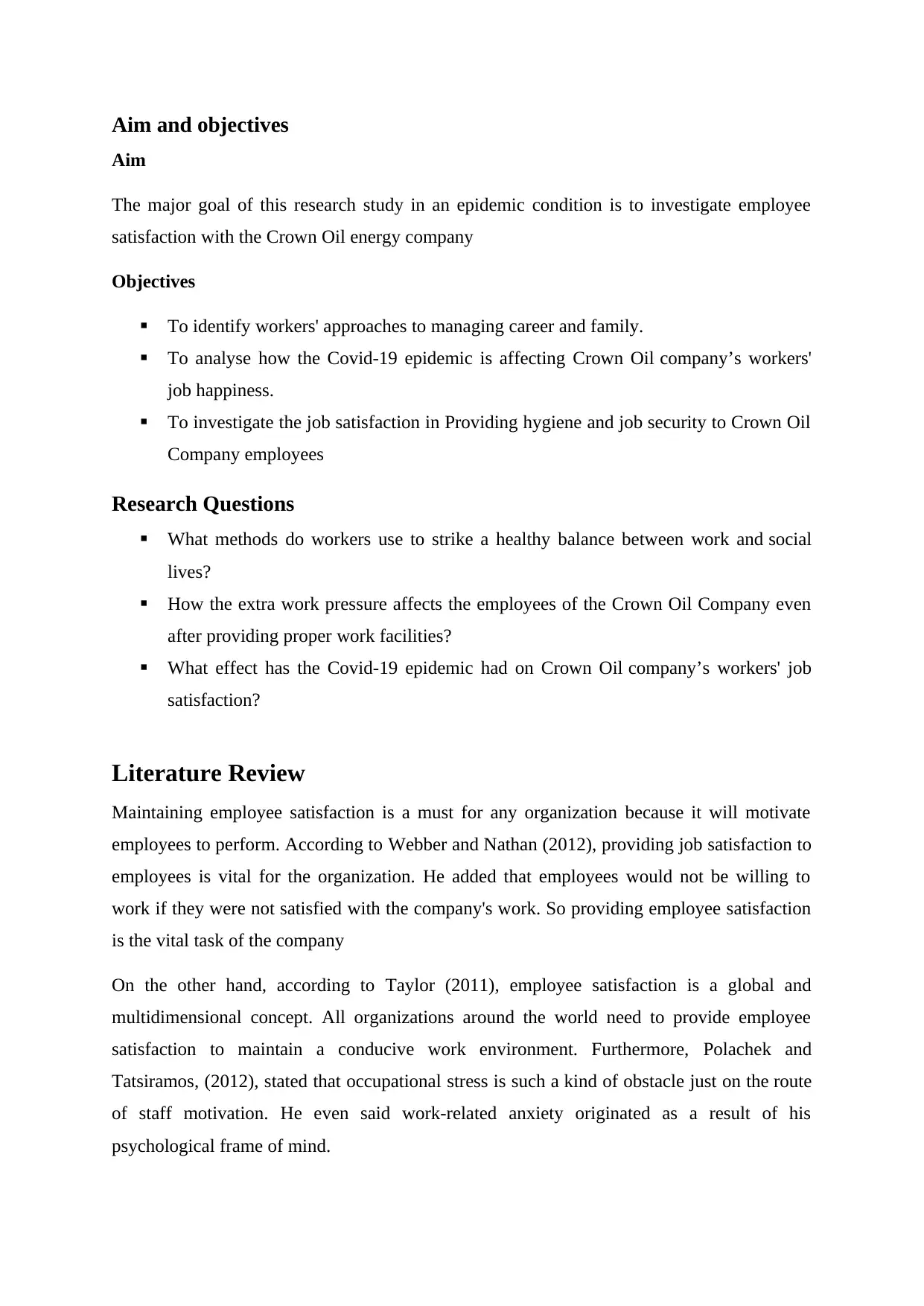
Aim and objectives
Aim
The major goal of this research study in an epidemic condition is to investigate employee
satisfaction with the Crown Oil energy company
Objectives
To identify workers' approaches to managing career and family.
To analyse how the Covid-19 epidemic is affecting Crown Oil company’s workers'
job happiness.
To investigate the job satisfaction in Providing hygiene and job security to Crown Oil
Company employees
Research Questions
What methods do workers use to strike a healthy balance between work and social
lives?
How the extra work pressure affects the employees of the Crown Oil Company even
after providing proper work facilities?
What effect has the Covid-19 epidemic had on Crown Oil company’s workers' job
satisfaction?
Literature Review
Maintaining employee satisfaction is a must for any organization because it will motivate
employees to perform. According to Webber and Nathan (2012), providing job satisfaction to
employees is vital for the organization. He added that employees would not be willing to
work if they were not satisfied with the company's work. So providing employee satisfaction
is the vital task of the company
On the other hand, according to Taylor (2011), employee satisfaction is a global and
multidimensional concept. All organizations around the world need to provide employee
satisfaction to maintain a conducive work environment. Furthermore, Polachek and
Tatsiramos, (2012), stated that occupational stress is such a kind of obstacle just on the route
of staff motivation. He even said work-related anxiety originated as a result of his
psychological frame of mind.
Aim
The major goal of this research study in an epidemic condition is to investigate employee
satisfaction with the Crown Oil energy company
Objectives
To identify workers' approaches to managing career and family.
To analyse how the Covid-19 epidemic is affecting Crown Oil company’s workers'
job happiness.
To investigate the job satisfaction in Providing hygiene and job security to Crown Oil
Company employees
Research Questions
What methods do workers use to strike a healthy balance between work and social
lives?
How the extra work pressure affects the employees of the Crown Oil Company even
after providing proper work facilities?
What effect has the Covid-19 epidemic had on Crown Oil company’s workers' job
satisfaction?
Literature Review
Maintaining employee satisfaction is a must for any organization because it will motivate
employees to perform. According to Webber and Nathan (2012), providing job satisfaction to
employees is vital for the organization. He added that employees would not be willing to
work if they were not satisfied with the company's work. So providing employee satisfaction
is the vital task of the company
On the other hand, according to Taylor (2011), employee satisfaction is a global and
multidimensional concept. All organizations around the world need to provide employee
satisfaction to maintain a conducive work environment. Furthermore, Polachek and
Tatsiramos, (2012), stated that occupational stress is such a kind of obstacle just on the route
of staff motivation. He even said work-related anxiety originated as a result of his
psychological frame of mind.
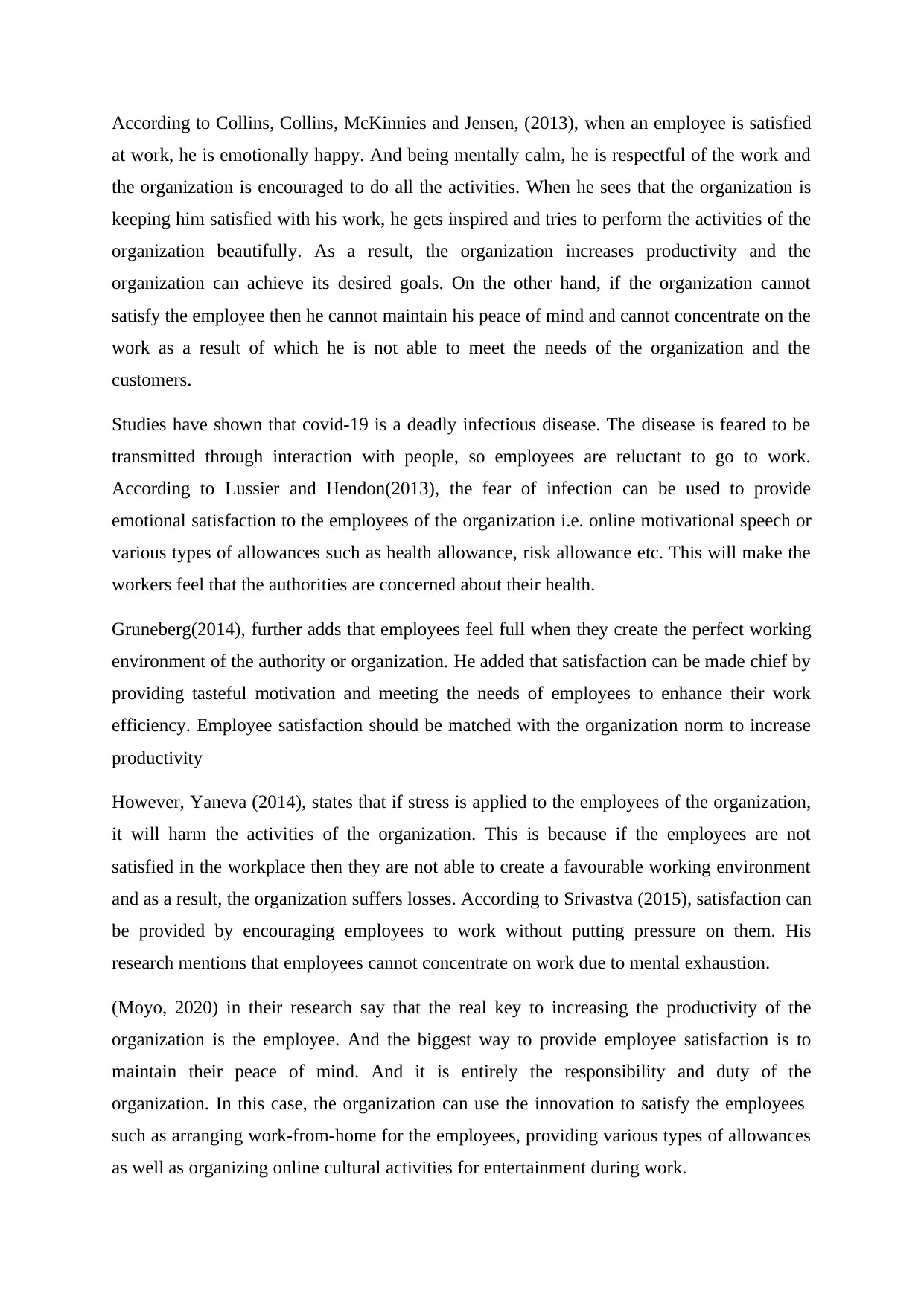
According to Collins, Collins, McKinnies and Jensen, (2013), when an employee is satisfied
at work, he is emotionally happy. And being mentally calm, he is respectful of the work and
the organization is encouraged to do all the activities. When he sees that the organization is
keeping him satisfied with his work, he gets inspired and tries to perform the activities of the
organization beautifully. As a result, the organization increases productivity and the
organization can achieve its desired goals. On the other hand, if the organization cannot
satisfy the employee then he cannot maintain his peace of mind and cannot concentrate on the
work as a result of which he is not able to meet the needs of the organization and the
customers.
Studies have shown that covid-19 is a deadly infectious disease. The disease is feared to be
transmitted through interaction with people, so employees are reluctant to go to work.
According to Lussier and Hendon(2013), the fear of infection can be used to provide
emotional satisfaction to the employees of the organization i.e. online motivational speech or
various types of allowances such as health allowance, risk allowance etc. This will make the
workers feel that the authorities are concerned about their health.
Gruneberg(2014), further adds that employees feel full when they create the perfect working
environment of the authority or organization. He added that satisfaction can be made chief by
providing tasteful motivation and meeting the needs of employees to enhance their work
efficiency. Employee satisfaction should be matched with the organization norm to increase
productivity
However, Yaneva (2014), states that if stress is applied to the employees of the organization,
it will harm the activities of the organization. This is because if the employees are not
satisfied in the workplace then they are not able to create a favourable working environment
and as a result, the organization suffers losses. According to Srivastva (2015), satisfaction can
be provided by encouraging employees to work without putting pressure on them. His
research mentions that employees cannot concentrate on work due to mental exhaustion.
(Moyo, 2020) in their research say that the real key to increasing the productivity of the
organization is the employee. And the biggest way to provide employee satisfaction is to
maintain their peace of mind. And it is entirely the responsibility and duty of the
organization. In this case, the organization can use the innovation to satisfy the employees
such as arranging work-from-home for the employees, providing various types of allowances
as well as organizing online cultural activities for entertainment during work.
at work, he is emotionally happy. And being mentally calm, he is respectful of the work and
the organization is encouraged to do all the activities. When he sees that the organization is
keeping him satisfied with his work, he gets inspired and tries to perform the activities of the
organization beautifully. As a result, the organization increases productivity and the
organization can achieve its desired goals. On the other hand, if the organization cannot
satisfy the employee then he cannot maintain his peace of mind and cannot concentrate on the
work as a result of which he is not able to meet the needs of the organization and the
customers.
Studies have shown that covid-19 is a deadly infectious disease. The disease is feared to be
transmitted through interaction with people, so employees are reluctant to go to work.
According to Lussier and Hendon(2013), the fear of infection can be used to provide
emotional satisfaction to the employees of the organization i.e. online motivational speech or
various types of allowances such as health allowance, risk allowance etc. This will make the
workers feel that the authorities are concerned about their health.
Gruneberg(2014), further adds that employees feel full when they create the perfect working
environment of the authority or organization. He added that satisfaction can be made chief by
providing tasteful motivation and meeting the needs of employees to enhance their work
efficiency. Employee satisfaction should be matched with the organization norm to increase
productivity
However, Yaneva (2014), states that if stress is applied to the employees of the organization,
it will harm the activities of the organization. This is because if the employees are not
satisfied in the workplace then they are not able to create a favourable working environment
and as a result, the organization suffers losses. According to Srivastva (2015), satisfaction can
be provided by encouraging employees to work without putting pressure on them. His
research mentions that employees cannot concentrate on work due to mental exhaustion.
(Moyo, 2020) in their research say that the real key to increasing the productivity of the
organization is the employee. And the biggest way to provide employee satisfaction is to
maintain their peace of mind. And it is entirely the responsibility and duty of the
organization. In this case, the organization can use the innovation to satisfy the employees
such as arranging work-from-home for the employees, providing various types of allowances
as well as organizing online cultural activities for entertainment during work.
⊘ This is a preview!⊘
Do you want full access?
Subscribe today to unlock all pages.

Trusted by 1+ million students worldwide
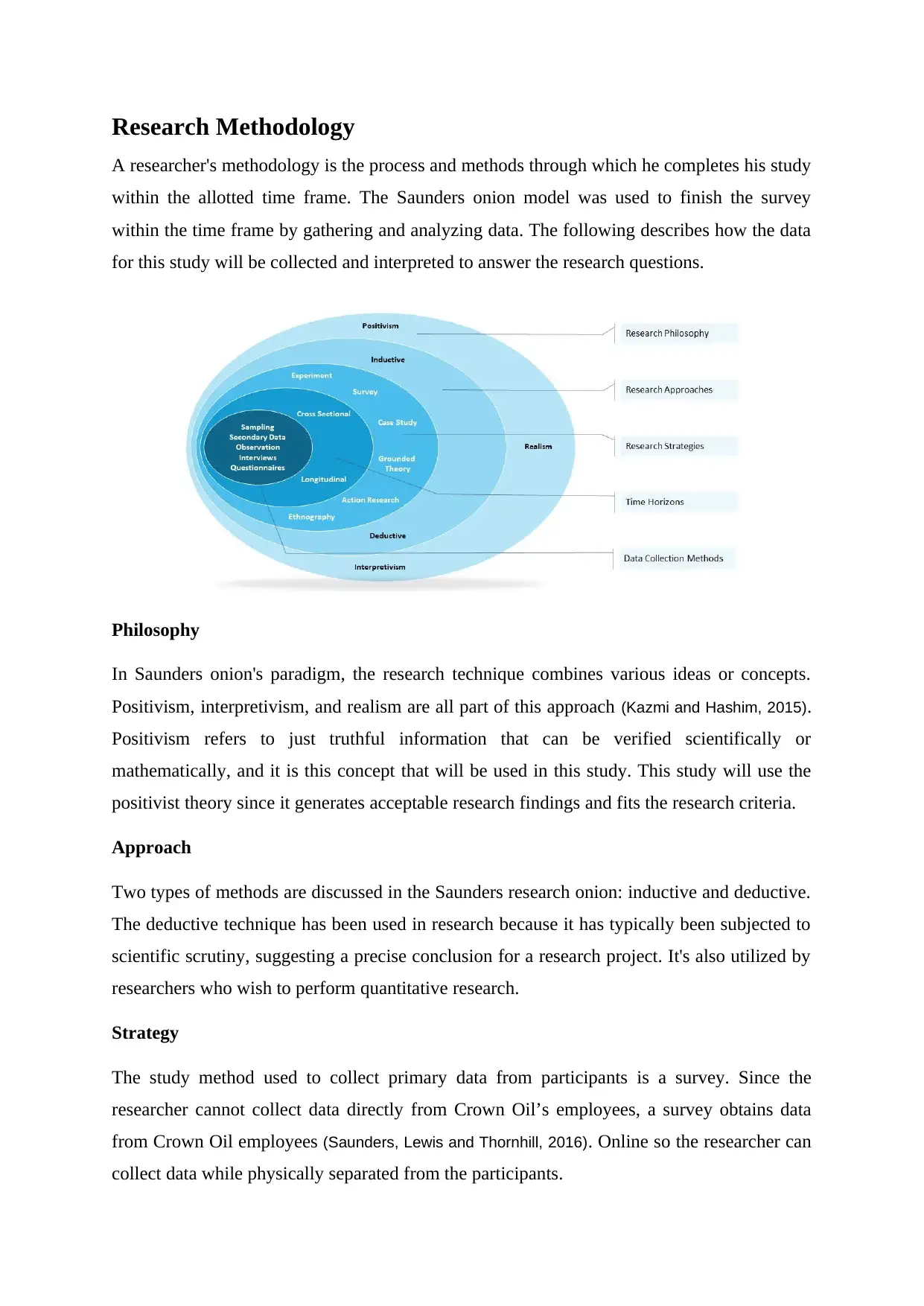
Research Methodology
A researcher's methodology is the process and methods through which he completes his study
within the allotted time frame. The Saunders onion model was used to finish the survey
within the time frame by gathering and analyzing data. The following describes how the data
for this study will be collected and interpreted to answer the research questions.
Philosophy
In Saunders onion's paradigm, the research technique combines various ideas or concepts.
Positivism, interpretivism, and realism are all part of this approach (Kazmi and Hashim, 2015).
Positivism refers to just truthful information that can be verified scientifically or
mathematically, and it is this concept that will be used in this study. This study will use the
positivist theory since it generates acceptable research findings and fits the research criteria.
Approach
Two types of methods are discussed in the Saunders research onion: inductive and deductive.
The deductive technique has been used in research because it has typically been subjected to
scientific scrutiny, suggesting a precise conclusion for a research project. It's also utilized by
researchers who wish to perform quantitative research.
Strategy
The study method used to collect primary data from participants is a survey. Since the
researcher cannot collect data directly from Crown Oil’s employees, a survey obtains data
from Crown Oil employees (Saunders, Lewis and Thornhill, 2016). Online so the researcher can
collect data while physically separated from the participants.
A researcher's methodology is the process and methods through which he completes his study
within the allotted time frame. The Saunders onion model was used to finish the survey
within the time frame by gathering and analyzing data. The following describes how the data
for this study will be collected and interpreted to answer the research questions.
Philosophy
In Saunders onion's paradigm, the research technique combines various ideas or concepts.
Positivism, interpretivism, and realism are all part of this approach (Kazmi and Hashim, 2015).
Positivism refers to just truthful information that can be verified scientifically or
mathematically, and it is this concept that will be used in this study. This study will use the
positivist theory since it generates acceptable research findings and fits the research criteria.
Approach
Two types of methods are discussed in the Saunders research onion: inductive and deductive.
The deductive technique has been used in research because it has typically been subjected to
scientific scrutiny, suggesting a precise conclusion for a research project. It's also utilized by
researchers who wish to perform quantitative research.
Strategy
The study method used to collect primary data from participants is a survey. Since the
researcher cannot collect data directly from Crown Oil’s employees, a survey obtains data
from Crown Oil employees (Saunders, Lewis and Thornhill, 2016). Online so the researcher can
collect data while physically separated from the participants.
Paraphrase This Document
Need a fresh take? Get an instant paraphrase of this document with our AI Paraphraser
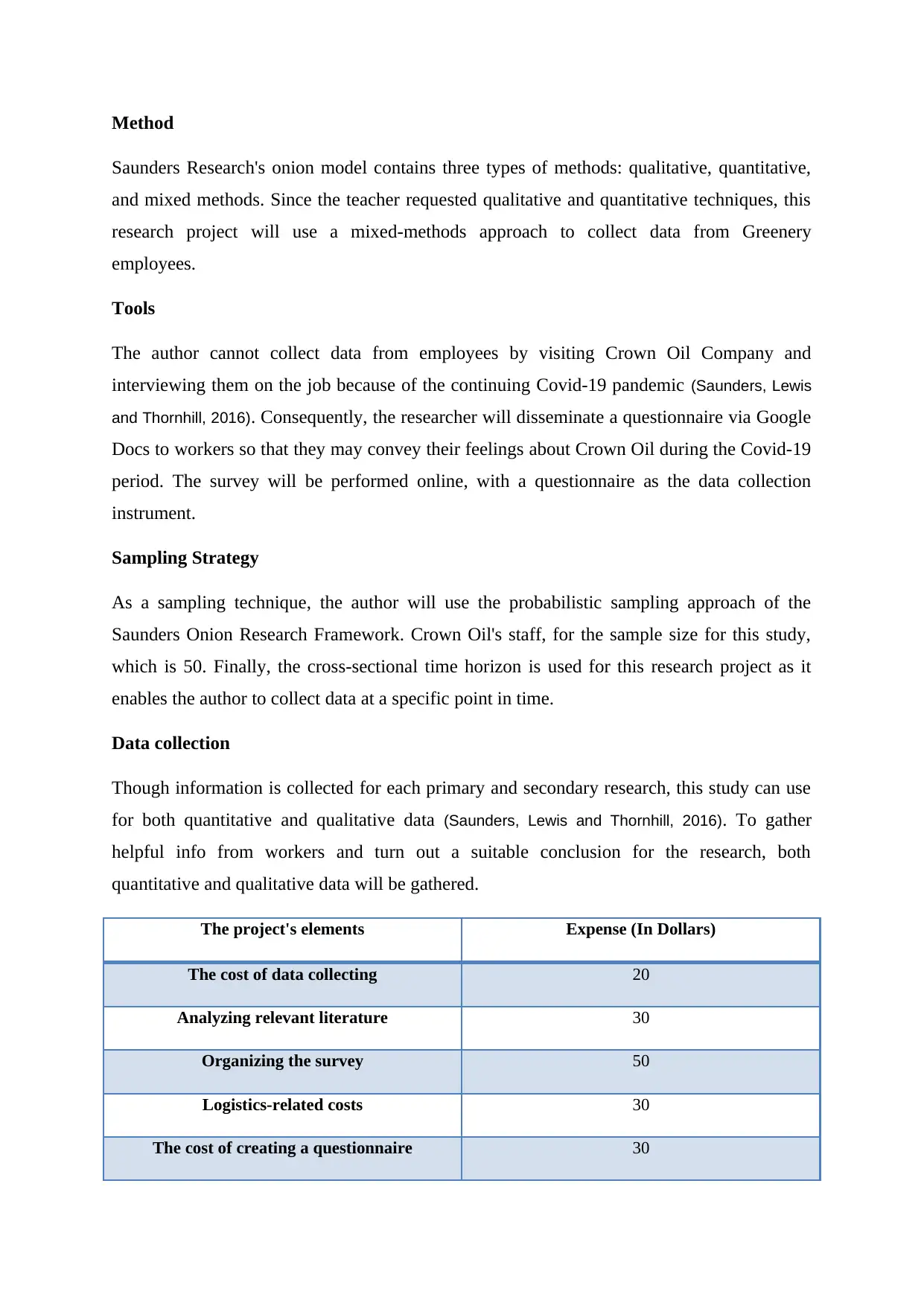
Method
Saunders Research's onion model contains three types of methods: qualitative, quantitative,
and mixed methods. Since the teacher requested qualitative and quantitative techniques, this
research project will use a mixed-methods approach to collect data from Greenery
employees.
Tools
The author cannot collect data from employees by visiting Crown Oil Company and
interviewing them on the job because of the continuing Covid-19 pandemic (Saunders, Lewis
and Thornhill, 2016). Consequently, the researcher will disseminate a questionnaire via Google
Docs to workers so that they may convey their feelings about Crown Oil during the Covid-19
period. The survey will be performed online, with a questionnaire as the data collection
instrument.
Sampling Strategy
As a sampling technique, the author will use the probabilistic sampling approach of the
Saunders Onion Research Framework. Crown Oil's staff, for the sample size for this study,
which is 50. Finally, the cross-sectional time horizon is used for this research project as it
enables the author to collect data at a specific point in time.
Data collection
Though information is collected for each primary and secondary research, this study can use
for both quantitative and qualitative data (Saunders, Lewis and Thornhill, 2016). To gather
helpful info from workers and turn out a suitable conclusion for the research, both
quantitative and qualitative data will be gathered.
The project's elements Expense (In Dollars)
The cost of data collecting 20
Analyzing relevant literature 30
Organizing the survey 50
Logistics-related costs 30
The cost of creating a questionnaire 30
Saunders Research's onion model contains three types of methods: qualitative, quantitative,
and mixed methods. Since the teacher requested qualitative and quantitative techniques, this
research project will use a mixed-methods approach to collect data from Greenery
employees.
Tools
The author cannot collect data from employees by visiting Crown Oil Company and
interviewing them on the job because of the continuing Covid-19 pandemic (Saunders, Lewis
and Thornhill, 2016). Consequently, the researcher will disseminate a questionnaire via Google
Docs to workers so that they may convey their feelings about Crown Oil during the Covid-19
period. The survey will be performed online, with a questionnaire as the data collection
instrument.
Sampling Strategy
As a sampling technique, the author will use the probabilistic sampling approach of the
Saunders Onion Research Framework. Crown Oil's staff, for the sample size for this study,
which is 50. Finally, the cross-sectional time horizon is used for this research project as it
enables the author to collect data at a specific point in time.
Data collection
Though information is collected for each primary and secondary research, this study can use
for both quantitative and qualitative data (Saunders, Lewis and Thornhill, 2016). To gather
helpful info from workers and turn out a suitable conclusion for the research, both
quantitative and qualitative data will be gathered.
The project's elements Expense (In Dollars)
The cost of data collecting 20
Analyzing relevant literature 30
Organizing the survey 50
Logistics-related costs 30
The cost of creating a questionnaire 30
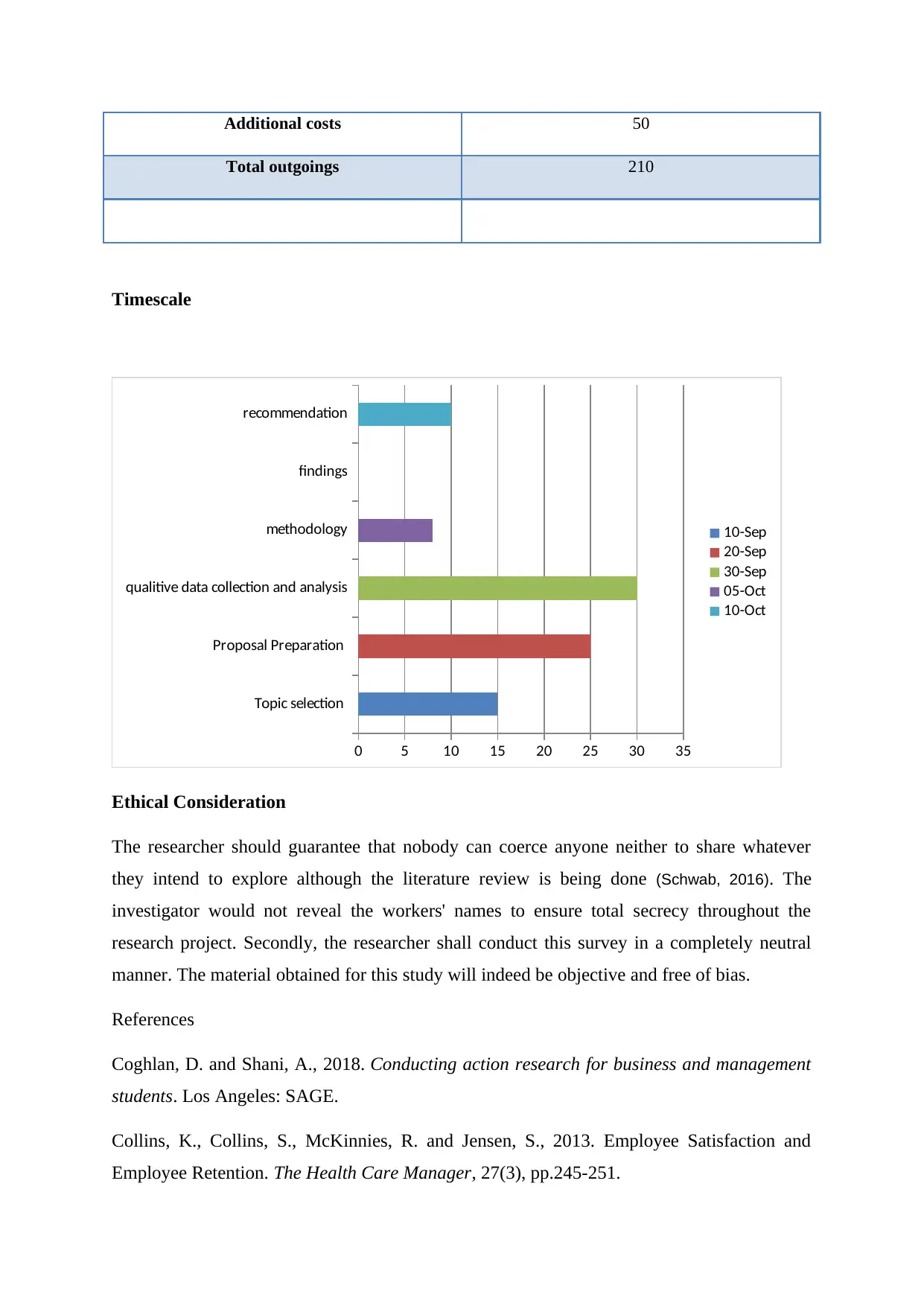
Additional costs 50
Total outgoings 210
Timescale
Topic selection
Proposal Preparation
qualitive data collection and analysis
methodology
findings
recommendation
0 5 10 15 20 25 30 35
10-Sep
20-Sep
30-Sep
05-Oct
10-Oct
Ethical Consideration
The researcher should guarantee that nobody can coerce anyone neither to share whatever
they intend to explore although the literature review is being done (Schwab, 2016). The
investigator would not reveal the workers' names to ensure total secrecy throughout the
research project. Secondly, the researcher shall conduct this survey in a completely neutral
manner. The material obtained for this study will indeed be objective and free of bias.
References
Coghlan, D. and Shani, A., 2018. Conducting action research for business and management
students. Los Angeles: SAGE.
Collins, K., Collins, S., McKinnies, R. and Jensen, S., 2013. Employee Satisfaction and
Employee Retention. The Health Care Manager, 27(3), pp.245-251.
Total outgoings 210
Timescale
Topic selection
Proposal Preparation
qualitive data collection and analysis
methodology
findings
recommendation
0 5 10 15 20 25 30 35
10-Sep
20-Sep
30-Sep
05-Oct
10-Oct
Ethical Consideration
The researcher should guarantee that nobody can coerce anyone neither to share whatever
they intend to explore although the literature review is being done (Schwab, 2016). The
investigator would not reveal the workers' names to ensure total secrecy throughout the
research project. Secondly, the researcher shall conduct this survey in a completely neutral
manner. The material obtained for this study will indeed be objective and free of bias.
References
Coghlan, D. and Shani, A., 2018. Conducting action research for business and management
students. Los Angeles: SAGE.
Collins, K., Collins, S., McKinnies, R. and Jensen, S., 2013. Employee Satisfaction and
Employee Retention. The Health Care Manager, 27(3), pp.245-251.
⊘ This is a preview!⊘
Do you want full access?
Subscribe today to unlock all pages.

Trusted by 1+ million students worldwide
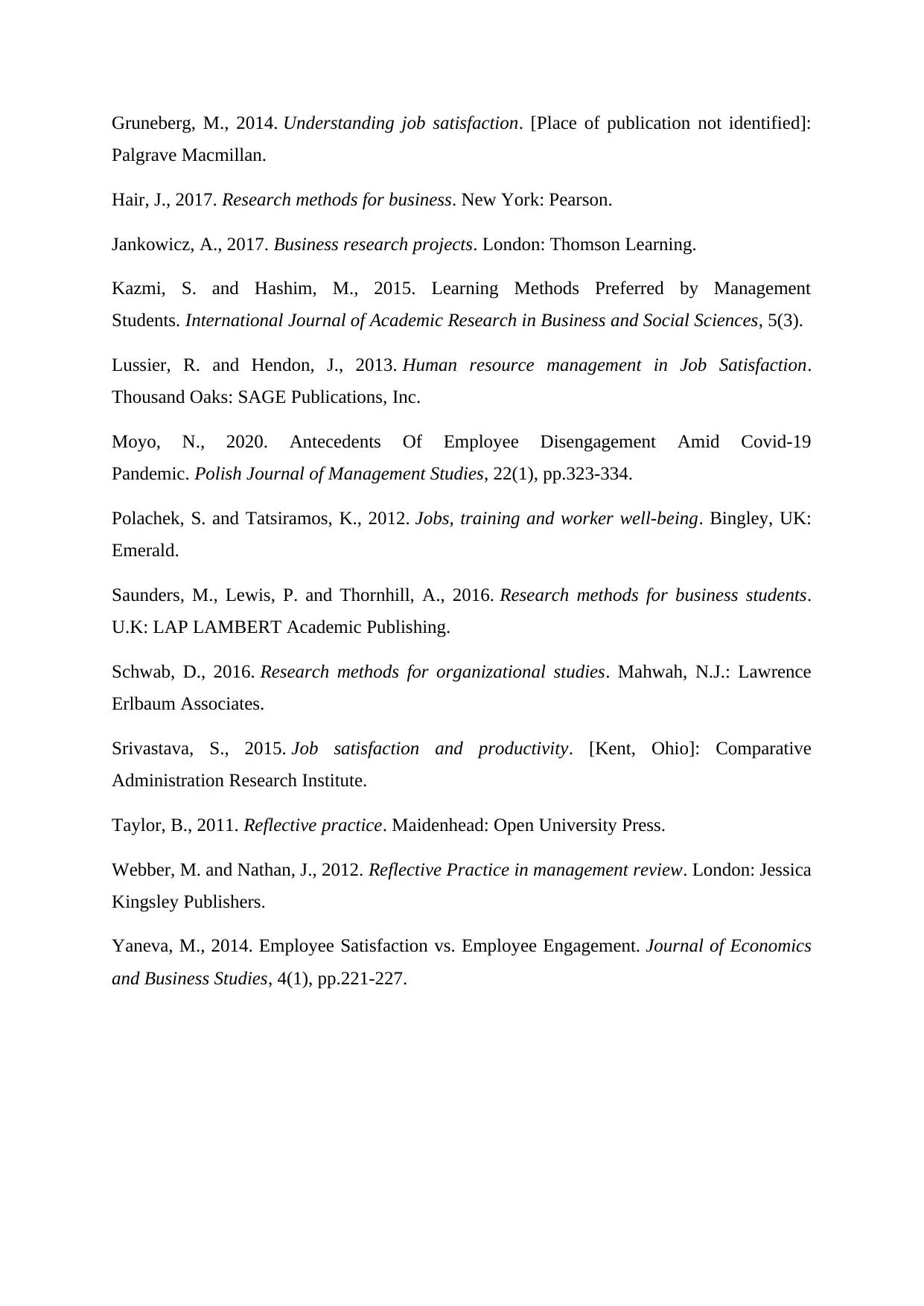
Gruneberg, M., 2014. Understanding job satisfaction. [Place of publication not identified]:
Palgrave Macmillan.
Hair, J., 2017. Research methods for business. New York: Pearson.
Jankowicz, A., 2017. Business research projects. London: Thomson Learning.
Kazmi, S. and Hashim, M., 2015. Learning Methods Preferred by Management
Students. International Journal of Academic Research in Business and Social Sciences, 5(3).
Lussier, R. and Hendon, J., 2013. Human resource management in Job Satisfaction.
Thousand Oaks: SAGE Publications, Inc.
Moyo, N., 2020. Antecedents Of Employee Disengagement Amid Covid-19
Pandemic. Polish Journal of Management Studies, 22(1), pp.323-334.
Polachek, S. and Tatsiramos, K., 2012. Jobs, training and worker well-being. Bingley, UK:
Emerald.
Saunders, M., Lewis, P. and Thornhill, A., 2016. Research methods for business students.
U.K: LAP LAMBERT Academic Publishing.
Schwab, D., 2016. Research methods for organizational studies. Mahwah, N.J.: Lawrence
Erlbaum Associates.
Srivastava, S., 2015. Job satisfaction and productivity. [Kent, Ohio]: Comparative
Administration Research Institute.
Taylor, B., 2011. Reflective practice. Maidenhead: Open University Press.
Webber, M. and Nathan, J., 2012. Reflective Practice in management review. London: Jessica
Kingsley Publishers.
Yaneva, M., 2014. Employee Satisfaction vs. Employee Engagement. Journal of Economics
and Business Studies, 4(1), pp.221-227.
Palgrave Macmillan.
Hair, J., 2017. Research methods for business. New York: Pearson.
Jankowicz, A., 2017. Business research projects. London: Thomson Learning.
Kazmi, S. and Hashim, M., 2015. Learning Methods Preferred by Management
Students. International Journal of Academic Research in Business and Social Sciences, 5(3).
Lussier, R. and Hendon, J., 2013. Human resource management in Job Satisfaction.
Thousand Oaks: SAGE Publications, Inc.
Moyo, N., 2020. Antecedents Of Employee Disengagement Amid Covid-19
Pandemic. Polish Journal of Management Studies, 22(1), pp.323-334.
Polachek, S. and Tatsiramos, K., 2012. Jobs, training and worker well-being. Bingley, UK:
Emerald.
Saunders, M., Lewis, P. and Thornhill, A., 2016. Research methods for business students.
U.K: LAP LAMBERT Academic Publishing.
Schwab, D., 2016. Research methods for organizational studies. Mahwah, N.J.: Lawrence
Erlbaum Associates.
Srivastava, S., 2015. Job satisfaction and productivity. [Kent, Ohio]: Comparative
Administration Research Institute.
Taylor, B., 2011. Reflective practice. Maidenhead: Open University Press.
Webber, M. and Nathan, J., 2012. Reflective Practice in management review. London: Jessica
Kingsley Publishers.
Yaneva, M., 2014. Employee Satisfaction vs. Employee Engagement. Journal of Economics
and Business Studies, 4(1), pp.221-227.
1 out of 7
Related Documents
Your All-in-One AI-Powered Toolkit for Academic Success.
+13062052269
info@desklib.com
Available 24*7 on WhatsApp / Email
![[object Object]](/_next/static/media/star-bottom.7253800d.svg)
Unlock your academic potential
Copyright © 2020–2025 A2Z Services. All Rights Reserved. Developed and managed by ZUCOL.





